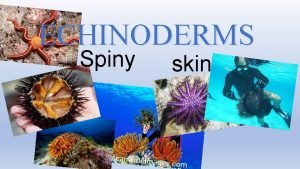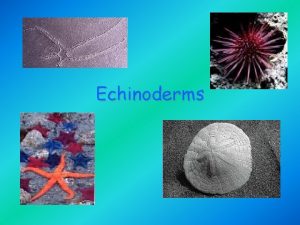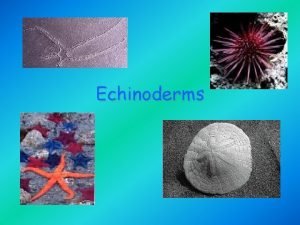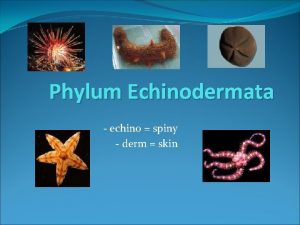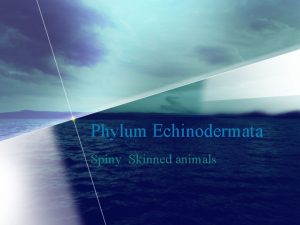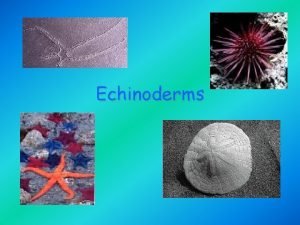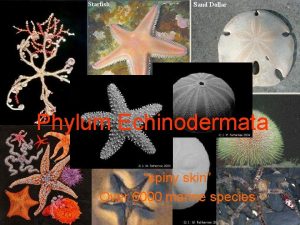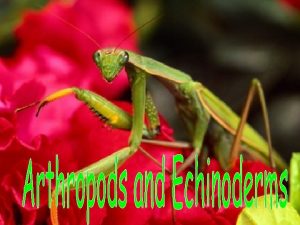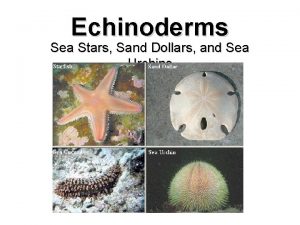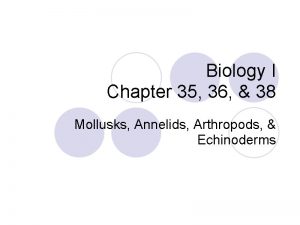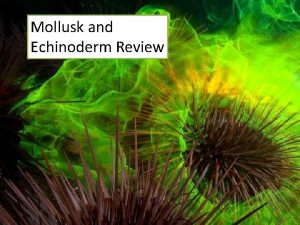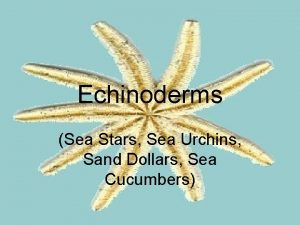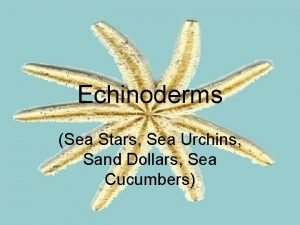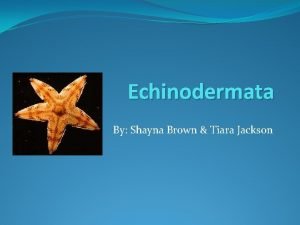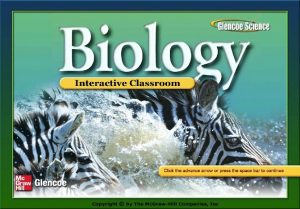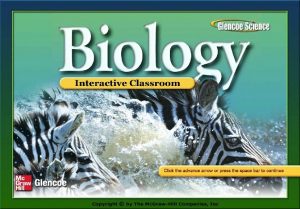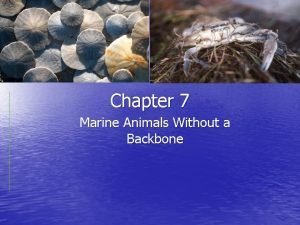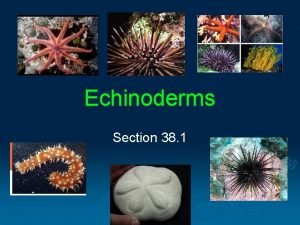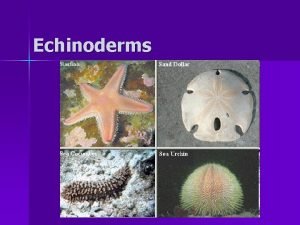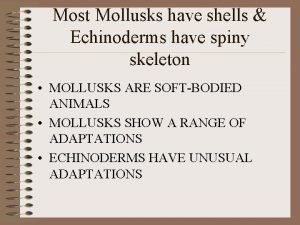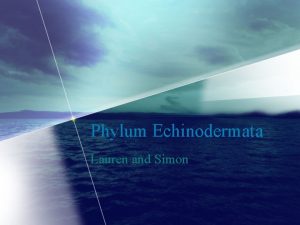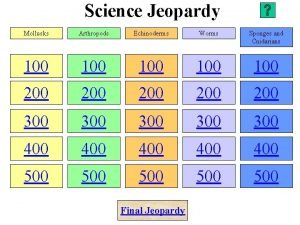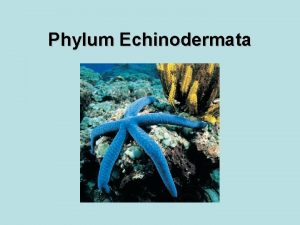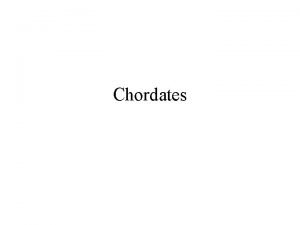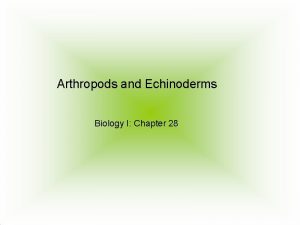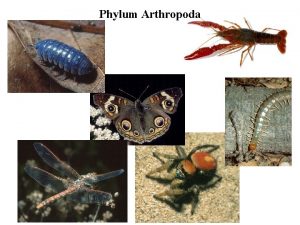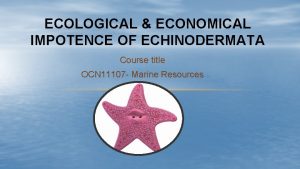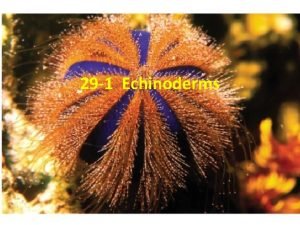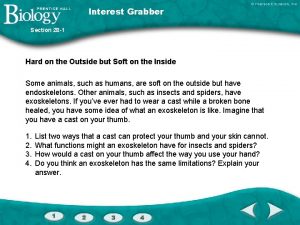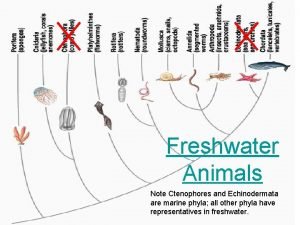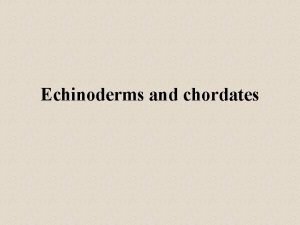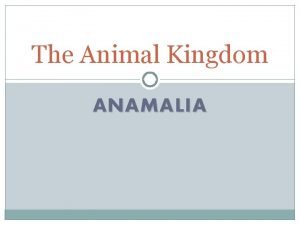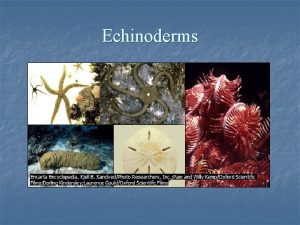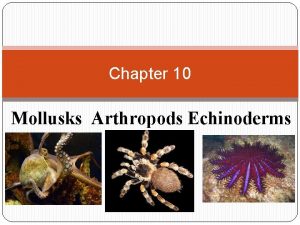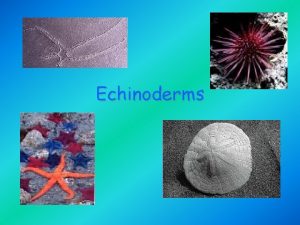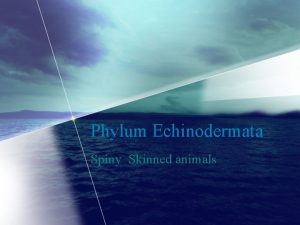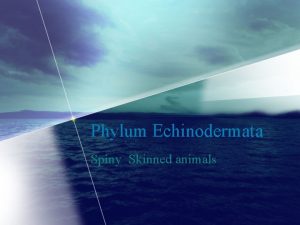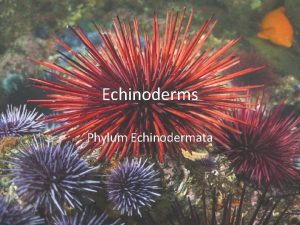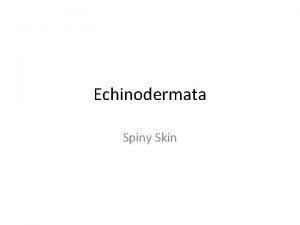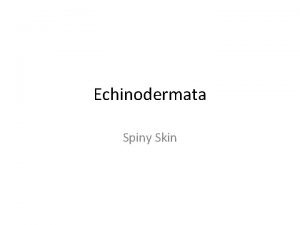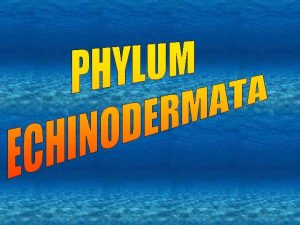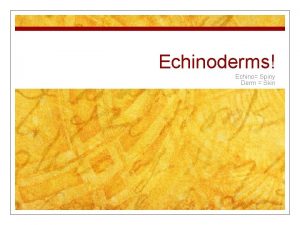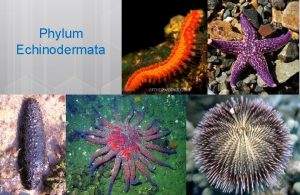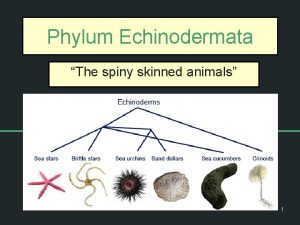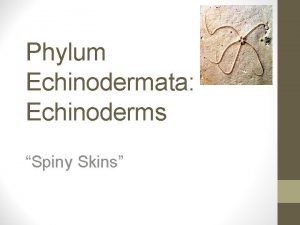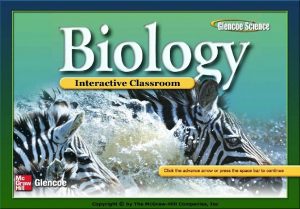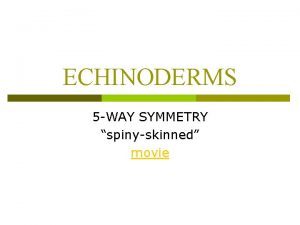Echinoderm means Most echinoderms have spiny skin There















































- Slides: 47

* Echinoderm means ________. Most echinoderms have spiny skin.

• There are ______ characteristics of echinoderms. • Most echinoderms have: • Spiny skin • Endoskeleton • A five part body “pentaradial” • A water vascular system • Tube feet

* The internal skeleton of an echinoderm is made of * An echinoderm’s water vascular system is

Sea urchins have longer and sharper ______ that they use to protect themselves. * * Some sea urchins have _______ spines.

* Sea urchins have a mouth hidden under its body. *A sea urchin uses its five teeth to eat ______. * A sea urchin is not very active. Sometimes, it does move slowly using its _____. When not moving it uses its feet to stick to the ocean floor.

* Sea cucumbers have a mouth on their leading end. * Their mouth is surrounded by _______ that grab up sand organic matter. Sea Cucumbers fight with guts.


Sea Stars (Starfish) Kingdom – Animalia Phylum – Echinodermata Class - Asteroidea * Starfish are also called _____________. Most Starfish have _____ arms (rays) connected to a central body.

On the bottom of the arms are hundreds of _______ that look like suction cups. *

Sea Stars have 2 sides Oral (mouth) and Bottom side Aboral top side http: //wwwbio 200. nsm. buffalo. edu/labs/tutor/Starfish 02 D. html

Oral side- Mouth- where food enters Ambulacral (alley) groove - where tube feet are located http: //wwwbio 200. nsm. buffalo. edu/labs/tutor/Starfish 02 D. html

Oral side- Mouth- where food enters Ambulacral (alley) groove - where tube feet are located Tube feet- used for movement and capturing prey Spines- made of calcium carbonate for protection http: //wwwbio 200. nsm. buffalo. edu/labs/tutor/Starfish 02 D. html

Review Tube feet Their function is ? Locomotion, suction cups can grab food, pry open clam shells, Also surface can exchange gases and nitrogen waste

Aboral side- 5 arms or rays- extensions off of central disc of sea star Madreporite- looks like a wart, allows water into the water vascular system http: //wwwbio 200. nsm. buffalo. edu/labs/tutor/Starfish 02 D. html

Aboral side- 5 arms or rays- extensions off of central disc of sea star Madreporite- looks like a wart, allows water into the water vascular system Spines- made of calcium carbonate for protection Disc- central portion of sea star http: //wwwbio 200. nsm. buffalo. edu/labs/tutor/Starfish 02 D. html

Sunflower Starfish • Diet: crabs, sea cucumbers, snails, sea urchins, and other sea stars • Size: Largest starfish 39 inches (1 m) and has up to 24 Arms • Range: Ocean waters from Alaska to San Diego • Relatives: other sea stars, brittle stars, urchins, sand dollars, sea cucumbers;

Sunflower Starfish - feeding

Review This opening on the oral surface is the mouth _______ This seastar is showing aboral you its ______ surface.

* A starfish is able to re-grow its arms. This is called Regeneration

…unless they contract sea star wasting syndrome!

Scientists now link starfish die-off to warming ocean • The wasting syndrome was linked to a virus and resulted in rapid disease spread, high death rates, and wasting that continued in survivors in 2015. • A warming ocean is a double whammy. Warmer than usual water can stress animals, and also make infectious agents more virulent. With so much heat added by human-caused climate warming, and sea surface temperatures on the rise nearly everywhere globally, more diseases will flourish.

Review A spines B Tube feet C ambulacral groove

Underneath the Madreporite is a tube like structure called Stone Canal- funnels water into the ring canal. Water Vascular System- closed water canals provide water pressure to move tube feet

The Stone Canal is connected to the Madreporite above and the Ring Canal- circular tube which branches into 5 tubes Ring Canal delivers water to the Radial Canal then to the Ampulla and finally to Tube Feet for movement

Radial Canal is inside the ambulacral ridge (plates) Along side the ambulacral plates are the ampulla

Ampulla – are the tops of the tube feet, they act like muscular water balloons that push and pull the water in and out of the tube feet

Digestive System 2 STOMACHS: CARDIAC STOMACH PYLORIC STOMACH

CARDIAC STOMACH: Connects to mouth can be extruded out through mouth to eat objects bigger than mouth.

CARDIAC STOMACH: Connects to mouth can be extruded out through mouth to eat objects bigger than mouth. When prey is captured the jelly-like stomach actually oozes out of the tiny mouth in a process known as eversion or evisceration. Everted stomach is turned inside out, exposing the digestive enzymes to prey. The liquefied food is then absorbed through the stomach lining and into the body

CARDIAC STOMACH everting or eviscerating

PYLORIC STOMACH: located between cardiac stomach and anus Connects to the digestive glands Have no intestines only digestive glands

Digestive Glands aka PYLORIC CECA: Attaches to stomach the gland breaks down food and absorbs it 2 sets in each arm

Sea stars are carnivores: Eat molluscs and other slow moving animals

Reproductive System Underneath the digestive glands (pyloric ceca) and close to pyloric stomach is the Gonads- males produce sperm; females eggs

Fertilization is External – sperm and egg unite outside of body in the water. Fertilized egg becomes a larvae (indirect development)

Sea Stars can reproduce both sexually (sperm and egg) Asexually (Regeneration) as long as part of the central disc is there. They can also lose an arm in self-defense, in a process called autotomy.

SKELETAL SYSTEM: INVERTEBRATES (NO backbone) ENDOSKELETON made of OSSICLES (web of calcium carbonate plates) Ossicles connect to surface SPINES AMBULACRAL RIDGE contains the RADIAL NERVE and RADIAL CANAL (Ambulacral canal)

(Open) Circulatory System No heart or blood vessels; Fluid (HEMOLYMPH) in COELOM bathes organs and distributes nutrients and oxygen

Nervous System: No head/no brain (NO CEPHALIZATION) NERVE RING encircles mouth and connects to RADIAL NERVES running inside the AMBULACRAL RIDGE in each arm to coordinate movements of tube feet Body can also sense temperature, chemicals, touch EYESPOT (called an ocelli)on tip of each arm senses light/dark

INTEGUMENTARY - ”Spiny skin” SKIN GILLS = hollow tubes on aboral surface exchange gases with water and excrete nitrogen waste; SPINES for protection connect to OSSICLES below PEDICELLARIA (=pinchers) keep surface free of organisms; in some species these are venomous

Sunflower star attempting to feed on red sea urchins and scallops http: //www. arkive. org/sunflower-star/pycnopodia-helianthoides/video-00. html

So, How do you Tell them APART? ? ? structural differences The Madreporite ALL echinoderms have a madreporite In asteroids madreporite is located on top or aboral surface In brittle stars located on bottom

Starfish have a deep Groove on the oral surface of their arms Brittle stars have no grooves but instead have flat plates

The arms and disk of a starfish tend to blend in with one another. Versus a Brittle Star where the center disk is more distinct from the arms

Living Sand Dollar!

Brittle Star Sea Lily Crown of Thorns

Scotoplanes or “Sea Pigs”
 A(n) _____ has an endoskeleton and usually a spiny skin.
A(n) _____ has an endoskeleton and usually a spiny skin. Spiny skin
Spiny skin Taxonomists have divided echinoderms into classes
Taxonomists have divided echinoderms into classes Endoskeleton and usually a spiny skin
Endoskeleton and usually a spiny skin Spiny skinned invertebrates
Spiny skinned invertebrates Starfish ampulla
Starfish ampulla Echinodermata
Echinodermata Spiny skinned animals have an endoskeleton formed with
Spiny skinned animals have an endoskeleton formed with Do starfish have a backbone
Do starfish have a backbone Sand dollar characteristics
Sand dollar characteristics The evolution of a coelom was significant because
The evolution of a coelom was significant because Mollusca endoskeleton
Mollusca endoskeleton Sand dollar
Sand dollar Sand dollar anatomy
Sand dollar anatomy Echinodermata body cavity
Echinodermata body cavity Chapter 27 section 1 echinoderm characteristics
Chapter 27 section 1 echinoderm characteristics Chapter 27 section 1 echinoderm characteristics
Chapter 27 section 1 echinoderm characteristics Marine animals without a backbone
Marine animals without a backbone Holothuroidea
Holothuroidea Echinoderms facts
Echinoderms facts Thick skin and thin skin
Thick skin and thin skin Thin skin vs thick skin
Thin skin vs thick skin Chapter 23 milady review questions
Chapter 23 milady review questions Origami japanese spiny lobster
Origami japanese spiny lobster Mollusca skeletal system
Mollusca skeletal system Spiny plates phylum
Spiny plates phylum 6 faces, 8 vertices and 12 edges
6 faces, 8 vertices and 12 edges Section 38-1 review echinoderms answer key
Section 38-1 review echinoderms answer key Phylum
Phylum Larval form of urochordata
Larval form of urochordata Chapter 28 arthropods and echinoderms
Chapter 28 arthropods and echinoderms Brittle stars phylum
Brittle stars phylum Characteristics of echinoderms
Characteristics of echinoderms Echinodermata
Echinodermata Echinoderms characteristics
Echinoderms characteristics Characteristics of echinodermata
Characteristics of echinodermata Description of echinoderms
Description of echinoderms Section 28-1 introduction to the arthropods answers
Section 28-1 introduction to the arthropods answers Order of animal
Order of animal Echinoderms and chordates
Echinoderms and chordates Are annelids cold blooded
Are annelids cold blooded Echinus diagram
Echinus diagram Oral surface of brittle star
Oral surface of brittle star Mollusks arthropods and echinoderms
Mollusks arthropods and echinoderms System ya
System ya If poly means many, what is gon?
If poly means many, what is gon? Meta means morphe means
Meta means morphe means Meta means change and morph means heat
Meta means change and morph means heat
